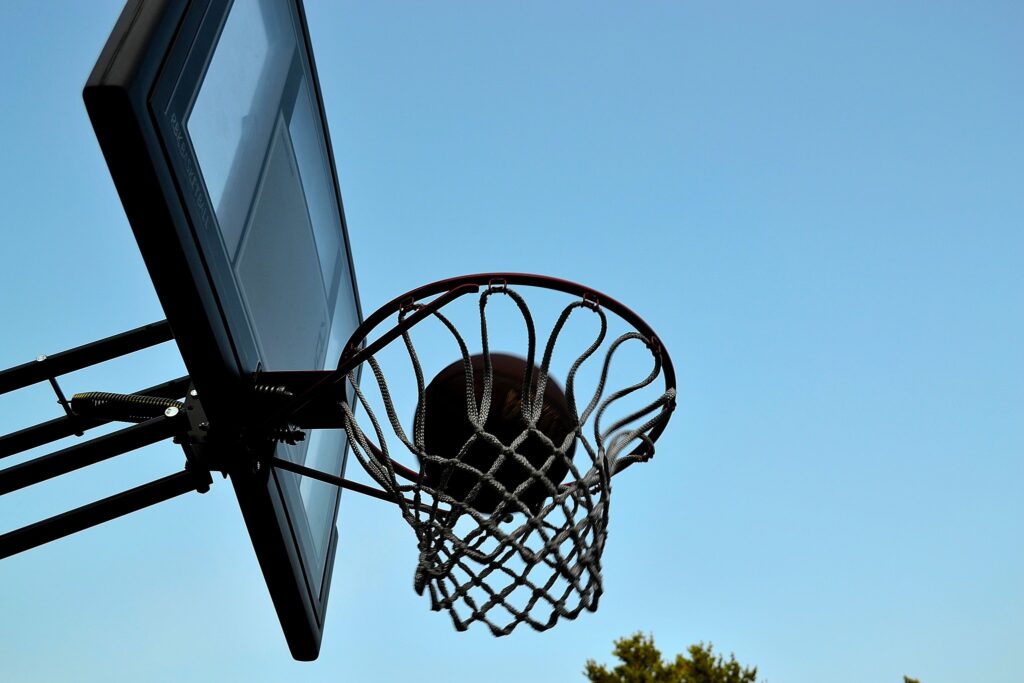
Step onto the hardwood court, where the echo of sneakers squeaking and the rhythm of bouncing balls resonate through time. The history of basketball is more than just a chronicle of sport; it’s a tale of innovation, resilience, and cultural phenomenon. From its humble beginnings in a Massachusetts gymnasium to its global status as one of the most beloved sports, this journey through hoops history is as exhilarating as a buzzer-beating shot. Let’s lace up our sneakers and embark on a thrilling exploration of the evolution of basketball, where each dribble tells a story and every slam dunk symbolizes triumph over adversity.
History of Basketball

The history of basketball is a captivating narrative that spans over a century, marked by the passion and ingenuity of its pioneers. It all began in December 1891, when Dr. James Naismith, a Canadian physical education instructor, sought to devise an indoor game to keep his students active during the harsh winter months in Springfield, Massachusetts.
With a simple set of rules and a soccer ball, Naismith hung two peach baskets at opposing ends of the gymnasium and instructed his students to throw the ball into the opposing team’s basket. Little did he know that this modest experiment would ignite a worldwide phenomenon.
In its infancy, basketball bore little resemblance to the fast-paced, high-flying sport we know today. Early games often saw scores in the single digits, with players navigating through a maze of opponents without the luxury of dribbling. However, as the sport gained popularity, it underwent many transformative changes.
The introduction of dribbling, the invention of the backboard, and the adoption of a standardized ball all contributed to basketball’s evolution into a thrilling and dynamic game. By the early 20th century, basketball had spread beyond the confines of the YMCA and became a staple in high schools and colleges across the United States.
In 1936, basketball made its Olympic debut at the Berlin Games, further cementing its status as a global sport. Over the decades, legends such as Bill Russell, Wilt Chamberlain, and Michael Jordan emerged, leaving an indelible mark on the game and inspiring generations of aspiring players.
Today, basketball transcends borders, cultures, and languages, captivating audiences worldwide with its athleticism, skill, and drama blend. From the hardwood courts of the NBA to the community playgrounds where dreams are born, basketball’s history is a testament to the enduring power of sport to unite and inspire.
The Early Years of BasketBall

The early years of basketball are steeped in a rich tapestry of innovation, athleticism, and sheer determination. Born out of the inventive mind of Dr. James Naismith in December 1891, this beloved sport has since captivated the hearts of millions worldwide. Yet, its humble beginnings tell a story of ingenuity amidst adversity, where a simple game devised to keep students active during the harsh winter months evolved into a global phenomenon.
Dr. Naismith, a Canadian physical education instructor at the International YMCA Training School in Springfield, Massachusetts, faced a unique challenge. Tasked with creating an indoor game that would keep his students engaged and physically active, he ingeniously conceptualized basketball. Drawing inspiration from games like “Duck on a Rock” and “Huckley-Buck,” Naismith sought to develop a sport emphasizing teamwork, skill, and agility while minimizing physical contact.
The first basketball game was played with a soccer ball and two peach baskets nailed to the lower railings of the gymnasium balcony, setting the stage for what would become an enduring tradition. Naismith unleashed a new era of athletic competition with just thirteen simple rules. The objective was straightforward: to score points by tossing the ball into the opposing team’s basket while adhering to rules that prohibited running with the ball and excessive physicality.
In these early years, basketball underwent rapid evolution. The game quickly spread across YMCA facilities and college campuses throughout the United States and Canada. As its popularity surged, modifications were made to equipment and rules, paving the way for a more fluid and dynamic style of play. The introduction of the backboard in 1893 and the adoption of the dribble in 1901 revolutionized the game, allowing for greater offensive creativity and strategic maneuvers.
One of the seminal moments in basketball’s early history occurred in 1936 when the sport made its Olympic debut at the Berlin Games. This marked a significant milestone, solidifying basketball’s status as a global sport and providing a platform for international competition.
Throughout its formative years, basketball was not immune to societal challenges. Segregation and racial discrimination cast a shadow over the sport, limiting opportunities for Black athletes to compete at the highest levels. However, pioneering figures like Earl Lloyd, Chuck Cooper, and Nat “Sweetwater” Clifton shattered racial barriers by becoming the first Black players to enter the NBA in 1950.
As the years passed, basketball continued to evolve, captivating audiences with its electrifying pace and unparalleled athleticism. From the rise of legendary players like Bill Russell, Wilt Chamberlain, and Michael Jordan to the globalization of the sport through initiatives like the NBA’s international outreach programs, basketball’s journey from its humble beginnings to its current prominence is a testament to the enduring spirit of competition and innovation.
In essence, basketball’s early years reflect a story of resilience, creativity, and boundless potential. From its modest origins in a Massachusetts gymnasium to its status as a global cultural phenomenon, basketball has transcended boundaries, uniting people from all walks of life in the spirit of sport and camaraderie.
First Public Game of BasketBall

The first public basketball game occurred on December 21, 1891, at the International YMCA Training School in Springfield, Massachusetts, USA. This historic event marked the culmination of efforts by Dr. James Naismith, a Canadian physical education instructor, who sought to invent a new indoor game to keep his students active during the cold winter months.
Naismith’s creation was initially a response to a challenge by his superiors to invent a new game that could be played indoors and would not be as physically rough as football or soccer. He devised a set of thirteen basic rules and nailed a peach basket to the balcony railing at each end of the gymnasium. The objective was simple: to throw a soccer ball into the opposing team’s basket.
The inaugural game featured two teams of nine players each. Although the rules differed somewhat from modern basketball, the game quickly gained popularity among students at the YMCA and spread rapidly to other schools and organizations.
Despite the simplicity of the equipment and rules, the game immediately captured the attention and enthusiasm of its players and spectators. Its appeal lay in its fast-paced action, skillful ball handling, and strategic teamwork.
The success of this first public basketball game paved the way for the sport’s rapid growth and development. Within a short period, basketball was played in schools, colleges, and YMCAs across the United States and eventually worldwide.
The significance of this first public game cannot be overstated. It marked the birth of a new sport that would become one of the world’s most popular and widely played games. Dr. James Naismith’s invention has endured the test of time, evolving into a global phenomenon that embodies the spirit of competition, athleticism, and teamwork.
Growth of the basket Ball Game

The growth of basketball over the decades has been nothing short of remarkable. From a simple game invented by Dr. James Naismith in 1891, it has become one of the most popular and widely played sports around the world. Several key factors have contributed to its exponential growth and global appeal.
Innovations in Gameplay
Basketball has evolved significantly since its inception. From the original peach baskets to modern hoops, the game has seen numerous rule changes and innovations, making it faster-paced, more dynamic, and exciting to watch and play. Developments such as the shot clock, three-point line, and various offensive and defensive strategies have enhanced the game’s appeal to players and spectators.
Globalization
Basketball’s spread beyond its birthplace in the United States has been instrumental in its growth. The sport gained traction internationally through events like the 1936 Olympic Games, where it was introduced. The formation of leagues like the NBA (National Basketball Association) in the U.S. and FIBA (International Basketball Federation) globally helped formalize and popularize the sport worldwide.
Media and Technology
The advent of television and later digital media platforms provided unprecedented exposure for basketball. Fans could now watch games from anywhere worldwide, helping cultivate a global fan base. Social media platforms further amplified the sport’s reach, allowing fans to engage with players, teams, and leagues directly and in real-time.
Athleticism and Entertainment
Basketball’s emphasis on athleticism, skill, and high-flying acrobatics has captured the imaginations of fans worldwide. Spectacular dunks, pinpoint passes, and clutch shots have become synonymous with the sport, drawing in new audiences and inspiring generations of players.
Community and Culture
Basketball’s inclusive nature has made it a unifying force across diverse communities and cultures. From street courts to professional arenas, the game fosters a sense of camaraderie and competition that transcends boundaries of race, nationality, and socioeconomic status.
Youth Development Programs
Grassroots initiatives and youth development programs have played a crucial role in nurturing talent and fostering a love for the game from an early age. Schools, clubs, and organizations worldwide offer opportunities for young players to learn, compete, and develop their skills, contributing to the sport’s overall growth and sustainability.
Celebrity Influence
The rise of basketball superstars like Michael Jordan, LeBron James, and Kobe Bryant has elevated the sport to new heights of popularity. Their talent, charisma, and global appeal have helped to elevate basketball into a mainstream cultural phenomenon, inspiring millions of fans and aspiring athletes.
The First official Basketball Game

The first official basketball game occurred on December 21, 1891, at the International YMCA Training School in Springfield, Massachusetts, USA. This historic event marked the culmination of efforts by Dr. James Naismith, a Canadian physical education instructor, who sought to invent a new indoor game to keep his students active during the cold winter months.
Naismith was tasked with creating a game that could be played indoors and would not be as physically rough as football or soccer. He devised a set of thirteen basic rules and nailed a peach basket to the balcony railing at each end of the gymnasium. The objective was simple: to throw a soccer ball into the opposing team’s basket. Thus, basketball was born.
The inaugural game featured two teams of nine players each, and according to historical accounts, the rules were somewhat different from modern basketball. Players could not dribble the ball but could only pass or shoot it. The game quickly gained popularity among students at the YMCA and spread rapidly to other schools and organizations.
Despite the initial challenges and quirks of the game, it captivated the imagination of players and spectators alike. The pace, skill, and strategy involved in basketball soon became evident, leading to its adoption as an official sport in various institutions across the United States.
Over time, basketball rules evolved, reflecting strategy, athleticism, and equipment changes. The introduction of dribbling, the shot clock, and the three-point line, among other innovations, transformed basketball into the dynamic and fast-paced sport known and loved by millions today.
The first official basketball game may have been a modest affair compared to the spectacle of modern basketball, but it laid the foundation for a global phenomenon. Dr. James Naismith’s creation has transcended.
Original Rules of the Game

The original basketball rules, created by Dr. James Naismith in 1891, were relatively simple compared to the modern game. Here are the original 13 rules:
- The Ball: The game shall be played with a round ball.
- The Court: The court shall be a rectangle, 50 feet wide and 94 feet long, with a basket at each end suspended 10 feet above the floor.
- The Team: Each team shall consist of nine players.
- Starting the Game: The game shall begin with a jump ball in the center of the court.
- Moving the Ball: Players cannot run while holding the ball. They may only pass, bat (but not hit), roll, or dribble the ball (dribbling was added later).
- Scoring: A goal shall be made when the ball is thrown or batted from the ground into the basket and stays there, providing the defending team does not touch or interfere with the goal.
- Violations: If a player holds the ball and makes no effort to advance it, the umpire shall call a violation and award the ball to the opposing team.
- Fouls: A player cannot hold, push, trip, or strike an opponent. The first violation of this rule shall count as a foul; the second shall disqualify him until the next goal is made. If there was evident intent to injure the person, no substitute is allowed for the whole game.
- Free Throws: If a player is fouled while attempting a goal, the fouled player is allowed one free throw from a designated spot.
- Out of Bounds: The ball is out of bounds when it touches the ground outside the courts’ boundaries or any object out of bounds.
- Throw-in: When the ball goes out of bounds, the person first touching it shall throw it into the field of play. In a dispute, the umpire shall throw it straight into the field.
- Change of Basket: Teams shall change baskets after each goal is made.
- Duration of the Game: The game shall consist of two 15-minute halves, with a five-minute rest period between halves.
Why is Basketball Played with 5 Players?

Basketball is traditionally played with five players on each team for several reasons.
Balance of Roles
Five players allow for a balanced distribution of roles on the court. This typically includes a point guard who orchestrates plays, shooting guards who excel at scoring, small forwards who are versatile both offensively and defensively, power forwards who are strong rebounders and defenders, and centers who dominate the paint and protect the rim.
Strategic Depth
Having five players allows for strategic depth and flexibility. Coaches can make substitutions to adjust to different matchups, exploit weaknesses in the opposing team’s defense, or counter specific offensive threats.
Historical Tradition
The five-player format has been a staple of basketball since its inception. Dr. James Naismith, who invented basketball in 1891, initially devised the game with nine players per team, but this was quickly reduced to seven and then eventually settled at five players per team.
Court Size and Space
The dimensions of a basketball court are optimized for five players on each team. With ten players on the court, there is enough space for fluid movement, passing, and shooting while maintaining competitiveness and engagement.
Economic and Practical Considerations
A team of five players is logistically easier to manage regarding travel, accommodations, and overall expenses than larger teams. Additionally, it allows for more opportunities for players to participate and develop their skills within a team setting.
Conclusion

As the final buzzer sounds on basketball’s rich history, it leaves an indelible mark on the canvas of sports culture. From Dr. James Naismith’s visionary invention to today’s global phenomenon, basketball’s journey is a tale of passion, perseverance, and boundless innovation.
As we reflect on the towering figures, iconic moments, and enduring legacies that have shaped the game, one thing is clear: basketball’s history is not just a story of the past, but a timeless narrative of triumph, unity, and the relentless pursuit of excellence. So, let’s continue to honor and celebrate this storied heritage as we dribble into the future, where the echoes of history inspire the champions of tomorrow.




